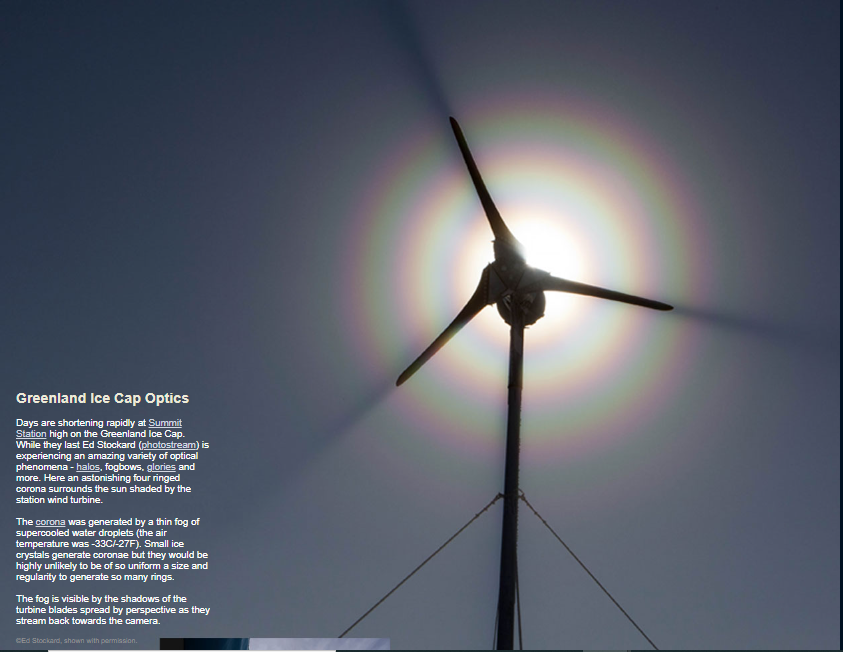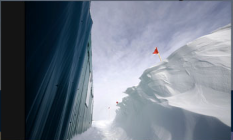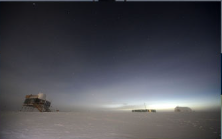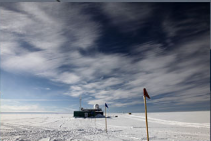OPOD - Greenland Corona
OPOD - Greenland Corona: Exploring the Spectacular Optics of the Greenland Ice Cap
The mesmerizing world of atmospheric optics never fails to amaze, and nowhere is this more evident than at Summit Station high on the Greenland Ice Cap. As the days rapidly grow shorter, photographer Ed Stockard has been fortunate enough to witness a breathtaking array of optical phenomena, ranging from halos and fogbows to glories and more. Among these incredible displays, one particular spectacle stands out: the four-ring corona encircling the sun, beautifully shaded by the station's wind turbine.
The corona's formation can be attributed to a thin fog composed of supercooled water droplets, with the air temperature plummeting to a bone-chilling -33°C (-27°F). While small ice crystals are typically responsible for generating coronae, it is highly unlikely for them to exhibit such uniformity in size and regularity as to create multiple rings. The presence of the fog becomes apparent through the shadows cast by the turbine blades, which appear elongated due to perspective as they stream towards the camera.
Coronae, like the one observed above Greenland, are a fascinating example of diffraction phenomena. When light encounters an individual water droplet, it scatters upon striking its surface. This scattered light then propagates outward as spherical waves. As these waves overlap and interfere with one another, intriguing patterns emerge. In regions where wave crests coincide, light intensifies, while destructive interference occurs when crests align with troughs from another wave, resulting in darkness.
The culmination of these wave interactions in the far field manifests as a circular diffraction pattern, characterized by a prominent bright central aureole encircled by progressively fainter rings. Each ring represents a different order of interference. The innermost ring corresponds to the first-order interference, followed by the second-order ring, and so on. The number of rings observed depends on various factors, including the size and uniformity of the droplets or ice crystals in the atmosphere.
While the visual spectacle of the Greenland corona is undoubtedly captivating, it is worth noting that this article has been automatically converted from the old site and may not appear as originally intended. For the original article, please refer to the link provided.
In conclusion, the extraordinary optical phenomena witnessed high on the Greenland Ice Cap serve as a reminder of the intricate beauty and complexity of our atmosphere. From halos and fogbows to the multi-ring corona encircling the sun, these ethereal displays offer a glimpse into the remarkable interplay between light and atmospheric particles. As we continue to explore and understand these phenomena, we gain a deeper appreciation for the wonders that surround us, both seen and unseen.

Greenland Ice Cap Optics
Days are shortening rapidly at Summit Station high on the Greenland Ice Cap. While they last Ed Stockard (photostream) is experiencing an amazing variety of optical phenomena - halos, fogbows, glories and more. Here an astonishing four ringed corona surrounds the sun shaded by the station wind turbine.
The corona was generated by a thin fog of supercooled water droplets (the air temperature was -33C/-27F). Small ice crystals generate coronae but they would be highly unlikely to be of so uniform a size and regularity to generate so many rings.
The fog is visible by the shadows of the turbine blades spread by perspective as they stream back towards the camera.
©Ed Stockard, shown with permission.





Coronae are a diffraction phenomena.
Light incident on an individual droplet is scattered from its surface. The scattered light propagates outwards as spherical waves.
The waves overlap and interfere. In directions where overlapping wave crests coincide there is light. Where crests coincide with troughs of the other wave there is destructive interference - darkness.
The result in the far field is a circular diffraction pattern of a bright central aureole surrounded by ever fainter rings.
Note: this article has been automatically converted from the old site and may not appear as intended. You can find the original article here.
Reference Atmospheric Optics
If you use any of the definitions, information, or data presented on Atmospheric Optics, please copy the link or reference below to properly credit us as the reference source. Thank you!
-
<a href="https://atoptics.co.uk/blog/opod-greenland-corona/">OPOD - Greenland Corona</a>
-
"OPOD - Greenland Corona". Atmospheric Optics. Accessed on November 26, 2024. https://atoptics.co.uk/blog/opod-greenland-corona/.
-
"OPOD - Greenland Corona". Atmospheric Optics, https://atoptics.co.uk/blog/opod-greenland-corona/. Accessed 26 November, 2024
-
OPOD - Greenland Corona. Atmospheric Optics. Retrieved from https://atoptics.co.uk/blog/opod-greenland-corona/.